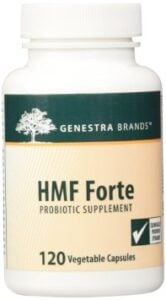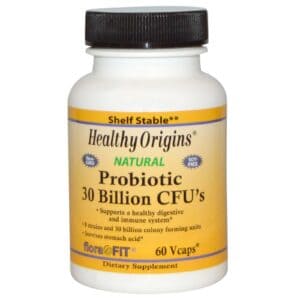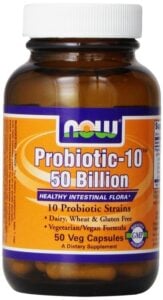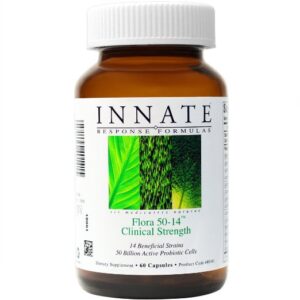It may not be Sunday, but it’s time to make a confession. If you’re like us, you’ve had that moment of weakness where you dig into that secret stash of junk food or indulged in Chianti-soaked summer soirées for weeks at a time, only to discover that your skin is looking a little, umm…saggy…with the unwelcome development of some crows feet.
If you’re lacking essential nutrients, your skin is a warning sign that something is going on internally. Now, that’s not to say you have to ditch the vino – we’re not crazy – but maybe it’s time to start thinking about tending to your skin’s needs from the inside out.
When discussing health and wellness, you may have heard of the term “probiotics”, the live bacteria that are beneficial to your digestive system. But did you know that probiotics are also a great addition to an effective preventative anti-aging routine? It can be found in foods that you eat every day like yogurt, kombucha tea, sauerkraut, and miso (as if you needed another excuse to go out to a sushi restaurant).
WHY PROBIOTICS?
Think of your stomach (and gut flora) as a delicate ecosystem that needs to be balanced. When we expose ourselves to various unhealthy toxins, like alcohol and sugars, our gut flora can be compromised and our ecosystem becomes imbalanced. This allows the bacteria in our body to create toxins (like lipopolysaccharides (LPS) that trigger inflammation and insulin resistance, or an accumulation of acetaldehyde (which can lead to an overgrowth of yeast in the gastrointestinal tract) to be released into the blood stream, causing inflammation throughout the body.
Results can involve skin irritation as well as visual signs of aging like the development of wrinkles and overly taught skin, due to lacking essential vitamins and nutrients.
By integrating probiotics into your daily routine, gut flora balance is restored and you strengthen your body from the inside out. Yes, “gut flora” is a weird term, but when it comes to preventative anti-aging it’s actually a very important part of your body to which we need to pay attention.
In fact, studies show that probiotics help line the gut and create a healthy barrier on the inside so as to prevent inflammation and help strengthen your skin barrier on the outside. Photoaging is damage caused by exposure to the elements, such as UV rays, and this study links inflammation to signs of aging like wrinkles as well as the overall depletion of collagen and elastin that keeps skin looking youthful. With the introduction of probiotics reducing inflammation internally, this piece of research displayed positive results including wrinkle prevention, collagen synthesis, and even UV damage repair (and what’s not to love about a bonus addition to your sunscreen)!
As the study confirmed that skin color was intensified, this improvement can result in a more balanced skin tone and even complexion. With this development, skin clarity is evened out and a more radiant tone is maintained when probiotics are introduced into the system.
5 STRAINS TO LOOK YOUNGER
In order to gain a deeper understanding of probiotics, let’s explore the five core species that, at first glance, may make you feel like you should have studied Latin in school…
THE SUPPORTER
Bifidobacterium bifidum – One of the most common probiotic bacteria, B. bifidum has the ability to break down complex carbohydrates, fat, and protein into small components. These small components are more efficient for your body to use and therefore can help prevent blockage in your system – which is one of the key elements to skin care and appearance. As mentioned before, if something’s going on inside, it will start to show on the outside. Breaking down complex carbs, proteins and fats helps your body digest nutrients with ease and keeps things moving so you can stay healthy on the inside, and out.
THE HEALER
Lactobacillus acidophilus – Probably the most important species to check off the list, L. acidophilus helps with nutrient absorption by colonizing the walls of the small intestine. This is crucial in healing from the inside out because the nutrients you digest replenish your skin’s appearance.
THE BOOSTER
Lactobacillus brevis – This is your go-to for immune boosters when choosing a probiotic. Strengthening your immune system is key to improving your overall health and appearance. A strong immune system helps determine parasites and viruses from healthy tissues which can affect your digestive health and skin composition.
THE REJUVENATOR
Bifidobacterium lactis – A probiotic found mostly in dairy products, B. lactis is known for supporting digestive health, boosting immune functions, and even easing stress and anxiety. Stress and anxiety increase cortisol production, which can result in collagen loss – a key component when combating signs of aging.
THE DETOXER
Bifidobacterium longum – A neutralizer of toxins in the gut, B. longum is a great way to detox while improving your immune health and overall digestion. Detoxing is a great way to get your skincare back on track and really combat signs of aging by increasing and maintaining collagen production.
As we mentioned before, probiotics may be found in foods common to regular diets – so why is there a need to integrate additional supplements as well? Although bacteria-rich food like yogurt and miso may have some probiotic strains, you probably would not get a solid dosage of the strains needed for maximum anti-aging benefits. In fact, the FDA (Food and Drug Administration) doesn’t even require brands to label the kinds of strains that are found within food and beverage packaging making it difficult to know if you’re consuming adequate amounts if any at all. Furthermore, since probiotics are heat sensitive, any products that actually contain them that have gone through pasteurization (heat processing) may contain virtually ineffective bacteria. In order to make the most of the probiotics found in food, look for the words, live active cultures on the packaging.
Through understanding the five core species, it’s possible to pick and choose which bacteria strains would be best for you based upon the results you are looking for.
RESEARCH, READ & REPEAT
Labels on any type of medication can be intimidating to read, so here are a few things to look out for when researching and purchasing your probiotic supplements.
CFUS
CFU stands for “colony forming units” and is a measurement system for the amount of good live bacteria found in one dosage of probiotics.
From 5 billion CFUs up to 25 billion, these numbers can dazzle the front label but you should try focus on quality over quantity. There is little scientific evidence to support the idea that more bacteria (or CFUs) are better. However, varying amounts of bacteria can increase stomach and digestive sensitivity depending on the strength. The number of different strains of bacteria (and the five core species mentioned above) should be your main focus, as each strain and species has a different benefit.
Generally, we recommend 10 billion CFUs per daily dose as a good start for getting some initial results. This is a gentle approach, and can be increased as you see fit – but a good rule of thumb is to slowly strengthen your dosage rather than going all in at 50 billion CFUs right off the bat. Additionally, 10 billion CFUs per dosage is a good level for maintenance once you’ve tested it out, or you could take a lower dosage depending on how your body reacted and what felt comfortable.
TIMING IS EVERYTHING
It is recommended to take your probiotic supplements first thing in the morning on an empty stomach. This allows your body to absorb the bacteria before it goes to work breaking down food.
THE MAGIC IS IN THE DELIVERY
Now you may be thinking stomach acids will break down the probiotic capsule before it has any real effect if taken on an empty stomach; however, research indicates that glucose capsules are one of the best ways to prevent acid breakdown in order to effectively deliver and maximize benefits of the probiotics in our system. Cellulose is the most common glucose-derived ingredient to look for when researching the capsule ingredients.
There are alternatives like gelatin or carrageenan capsules and proper labeling will describe the details for “delivery” on how probiotics can stand up to the acidity in your body. Be sure to read and research this aspect thoroughly.
THE FRIDGE IS YOUR FRIEND
As a rule of thumb, probiotics should be stored in the fridge or in a cool dark place as the bacteria is sensitive to light and heat.
RESULTS, RESULTS, RESULTS
Results can be noticed (on the inside and out) within a few days of taking probiotics. However, do not be deterred if it takes a few weeks to take note of any changes – just stick with it. Good things sometimes take time, and everyone digests differently.
Overall clarity in your skin should be seen within the first week or two. This is usually the time that your body is starting to rejuvenate and detoxify itself, so expect to fluctuate with a few small breakouts before clearing up and looking radiant again.
After that, expect a month or two for skin repair, collagen renewal, and decreased wrinkles to take place. Everyone is different, but usually allowing an 8-week period to see optimum results is the best way to allow your body enough time to go through the process.
SIDE EFFECTS
Although complications are rare, some may react negatively to the use of probiotics. Further research is still needed about who should avoid probiotics, but most products warn those with autoimmune diseases to consult a physician first. When you first start probiotics, you may experience changes in your digestion, such as bloating or distension in your stomach, within the first few days. This is normal, and you should start to feel and notice positive results after that.
As with most supplements, be sure to check the packaging for additional potential complications and side effects, and always check with your physician if you are taking any other medications that could be affected.
Now that you know what to look for when choosing your probiotic supplement, we’ve listed our top favorites for skin rejuvenation and preventative anti-aging.
PRODUCT RECOMMENDATIONS
Genestra HMF Forte $55.60 (Cellulose Capsules)
With Lactobacillus acidophilus to assist with nutrient absorption and Bifidobacterium bifidum to break down complex carbohydrates, fat and protein, Genestra HMF Forte with 10 billion CFU per dose is a great probiotic to start with. It’s moderate and known for long-term maintenance, so you can expect to see steady results over time. Adding Bifidobacterium lactis can assist with easing anxiety and stress, which will help with collagen production for anti-aging results.
Healthy Origins Natural Probiotic 30 Billion CFU $33.79 (Cellulose Capsules)
Healthy Origin’s formula is acid-resistant, so the absorption rate of the 30 Billion CFUs is very good. Among the several beneficial bacteria included in the capsules, B. longum is included to neutralize toxins in the gut to help combat signs of aging by maintaining or increasing collagen production.
Now Foods Probiotic- 10 $13.82 (Cellulose Capsules)
With 50 billion probiotic bacteria and 10 strains, Now Food’s Formula is a potent dosage for those entering the world of probiotics. Lactobacillus casei is integrated into the mix to complement the growth of L. acidophilus, which is the key ingredient to nutrient absorption.
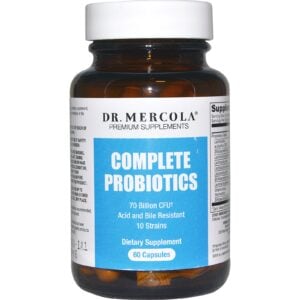
Dr. Mercola Complete Probiotics $72.99 (Cellulose capsules)
This product is resistant to acid and bile and claims a 90% absorption rate in the body. This will definitely help your body receive all of the benefits of this little gem, including 70 billion gut-friendly bacteria, with L. acidophilus and Bifidobacterium to help support your digestive system and remove those harmful toxins on the inside that can affect our appearance on the outside. We also love how the shelf life of 18 months keeps this supplement effective for an extended period of time.
Innate Response – Flora 50-14 Clinical Strength $67.96 (Cellulose Capsules)
Containing 14 clinically researched strains and a dose of 50 billion probiotic bacteria, this is another impressive formula. It includes all of the five main strains we mentioned above that can assist in looking younger and are ideal to include when it comes to preventative anti-aging.
FINAL THOUGHTS
When you’re going through the process of trying probiotics, we recommend journaling the results you experience as this will be a great way to look back on what worked, what didn’t, and what to try next.

